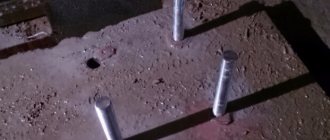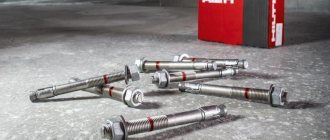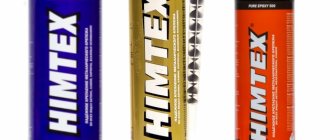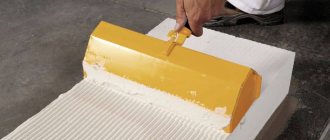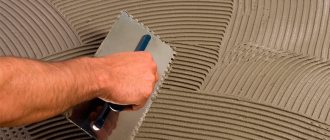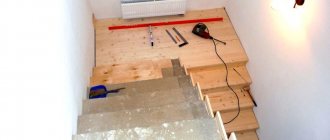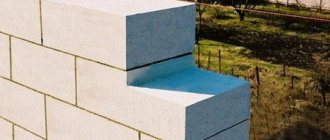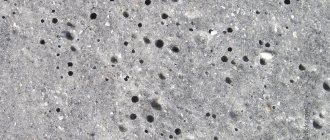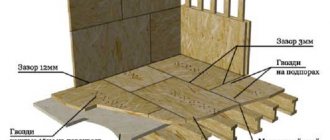During construction work, it becomes necessary to mechanically connect structural elements. Builders and installers do this using dowels made of plastic or metal. Hardware is used with solid stone, brick, and concrete bases. An alternative is chemical anchors. Therefore, builders opt for Hilti glue for anchors, which is produced in Liechtenstein. Products are produced in the form of capsules and injections.
Installation of reinforcement outlets using Hilti chemical anchors
The production of Hilti adhesive anchors is based on epoxy resin and urethane methacrylate. These products are used for fastening mounting and working fittings. The adhesive anchor is selected according to calculations taking into account the following factors:
- load level on the reinforcing bar;
- base temperature;
- depth, diameter and other dimensional characteristics of the embedment.
The technology of reinforcement outlets using Hilti anchors is used in Europe and the Russian Federation. Hilti chemical anchor products can be used to solve various construction and installation problems.
Chemical capsule anchors "Hilti"
This type of Hilti glue for anchors is presented in the form of a capsule. Each capsule is designed for mounting one fastener element. The capsules themselves are represented by cylindrical containers filled with glue. This is a two-component composition, the mixing of which is carried out during installation.
Such products are marked HVU, which indicates:
- depth of permissible mounting hole;
- thread of the anchor stud.
For example, if a product is marked HVU M14X100, then this indicates a hole depth of 100 mm in the base and an anchor pin with M14 thread.
The Liechtenstein company produces chemical anchors for a wide range of threads: from M8 to M39.
The process of installing a stud using such a capsule is approximately as follows:
- First, a hole of the required diameter and depth is drilled in the base. The manufacturing company advises choosing a drill diameter 2-3 mm larger for studs with threads from M8 to M16, and 3-4 mm larger for studs with threads from M20 to M39.
- Then the drilled hole must be cleaned of dust using compressed air or any mechanical method.
- Next, you need to insert the Hilti chemical capsule into the hole.
- After this, you need to screw the pin clockwise into the hole (it will damage the capsule, due to which the components will mix and the solution will begin to harden).
At positive ambient temperatures, the solution will completely harden in about 20-60 minutes. At temperatures around zero or below, it will take several hours to harden. To install metal products that experience severe dynamic loads during operation, it is recommended to use special HVU-TZ capsules.
Technology of using chemical anchors
Working with anchors begins with marking the holes, then you need to drill the holes using special equipment, it is better to use a diamond one, this way you will get perfectly smooth surfaces.
Next you need to clean the walls of the holes with a brush and blow them out with a hand pump. Then install the anchor in the hollow base of the mesh sleeve, then also install the mixer on the cartridge and remove approximately ten centimeters of the contents until a homogeneous composition appears.
Through the mixer, squeeze the contents into the hole to fill two-thirds, at this time the mixer is inserted to the bottom. Install the fastener, at this time you can control its position until it hardens completely.
Return to contents
Hilti injection anchor systems
Such chemical anchors are marked HIT and are presented in a plastic cartridge with foil containers (one contains glue, the other contains a hardener composition). The Liechtenstein manufacturer Hilti offers a choice of seven types of such anchors. This type of Hilti glue for anchors differs in the following characteristics:
- scope of use;
- glue component and hardener type;
- cartridge volume (330 ml or 500 ml);
- permissible load on the stud.
A striking example of the company’s products from Liechtenstein is HIT-MM-Plus glue, which is the most popular and inexpensive (a 330 ml container costs about 700-1000 rubles). Two-component adhesive made from urethane methacrylate.
The manufacturer recommends using it for mounting studs, the thread of which varies from M6 to M16. Installation is carried out in the following types of bases:
- brick;
- concrete;
- block;
- stone (artificial and natural stone).
The most expensive type of product is HIT-RE-500-V3 glue, the cost of which is about 3,000 rubles. It is used for installation of releases of load-bearing reinforcement elements of floors, foundations, stairs, columns. The glue is made on the basis of epoxy resin with additives, due to which it is capable of holding reinforcement with a diameter of 10 to 55 mm.
Varieties
On the building materials market, Hilti dowels are presented in two samples; these are compositions that obtain the characteristics described above only after injection and ampoules. And also such types of anchors as: HILTI HVU, HILTI HIT-HY, HILTI HIT-MM PLUS, HILTI HFX, HILTI HIT-RE 500, HILTI HIT-ICE.
Return to contents
HIT-RE 500
This type of chemical dowels has all the advantages of a conventional anchor. It differs from the others in its scope of application. It is used in holes with moisture, in water-saturated concrete, when gluing outlets of working reinforcement, fastening load-bearing and auxiliary structures, and reconstructing bridges. If you choose this type of dowel, it will be easy to control due to its color, it does not emit an unpleasant odor and is easy to use.
Return to contents
HFX
This anchor is well suited for renovating living spaces, installing mounts for household appliances, various shelves, and plumbing fixtures. It is easy to use and hardens quickly. You also don’t need to buy a special dispenser, and you can take a break from work when the capsule is opened.
Return to contents
HIT-ICE
The main advantage of this chemical dowel for concrete is the ability to install even at minus twenty-three degrees Celsius. Simple and quick dosing is possible even at sub-zero temperatures. And also you will not lose time, because you will be able to work in the winter.
Return to contents
Adhesive anchor Hilti HIT-RE-100
This type of Hilti glue for anchors is made on the basis of epoxy resin and hardener, and is two-component (the components are mixed during installation).
Using these products, the following construction and installation work is performed:
- installation of additional metal structural parts;
- installation of load-bearing metal structures (beam, column and other types);
- replacing incorrectly installed reinforcing bars or installing missing reinforcement;
- installation and connection of concrete reinforcement bars.
The Hilti anchor HIT-RE-100 has a wide operating temperature range: from -40 to +70° C. These products can be stored and transported at temperatures from +5 to +25° C. Tools for its installation are: HDM, HDE 500-A22.
Technological process for installing Hilti HIT chemical anchors
Transcript
1 Technological process for installing Hilti HIT chemical anchors 1. Scope of application of chemical anchors. Chemical anchors are designed for installing columns, various building structures, fastening products and equipment to various types of base materials (Concrete, natural stone, wet concrete, brickwork, foam concrete masonry). Gluing of reinforcement. 2. Product Characteristics Chemical anchoring consists of two components: a metal rod and a chemical composition. The chemical composition penetrates the pores of the base material, and after hardening, reliably connects the metal rod to the base material. A. Chemical composition. The composition comes in several types: HIT-RE 500, HIT-RE 500SD, HIT-HY 200 (HIT-HY 150) Its choice depends on three factors: the applied load (the nature of the connection), the base material, the temperature of the base material. The choice of chemical composition, for all factors, is described in the Hilti product catalog and in the Hilti Anchor Guide. B. Pasted part. The glued part is selected depending on the nature of the connection. It can be: a pin a bushing (with internal thread) a fitting The insertion depth for standard loads is described in the Hilti catalog and manual. Reinforcement Capsule with chemical composition (330ml, 500ml, 1400ml)
2 3. Preparation for installation. Before starting work on the installation of chemical anchors, it is necessary to check the compliance of the markings indicated on the anchor with the markings in the project documentation. The anchor marking is indicated on the chemical anchor capsule. It is also necessary to check the expiration date of the composition. Installation of anchors must be carried out in accordance with Table 1 and with the table for the time of complete hardening of chemical anchors (see Table 2). In case of installation at the temperature indicated in the table below, after cleaning the hole, it is necessary to warm it up using a hair dryer or propane torch, avoiding soot deposit on the walls of the hole. Tables of temperature setting and complete hardening of the chemical anchor table 1 Hit Re 500 HIT-RR 500-SD HIT-HIT hours of 72 hours 0 3 hours 50 hours 5 2 hours 24 hours 20 30mures 30 20min 40 12min 4 hours TGEL-TCUR setting time-full hardening time recommended pace. during transportation C 5 2.5 hours 72 hours 10 2 hours 48 hours 15 1.5 hours 24 hours 20 30 min 12 hours 30 20 min 8 hours 40 12 min 4 hours min 720 min -5 40 min 240 min 0 20 min 120 min 5 8 min 60 min 20 5 min 30 min 30 3min 30min 40 2min 30min 4. Installation 4.1 Drilling a hole Drilling a hole can be done in two ways: Diamond drilling (DD EC-1) This method is most preferred when installing mechanical anchors. The hole turns out to be perfectly smooth and round; when it hits the reinforcement, the bit does not deviate from the planned trajectory; if necessary, the reinforcement can be easily re-drilled; drilling is done using a shockless method (the reinforcement does not peel off). Drilling with a hammer drill (TE-2, TE-6, TE-30, TE-40, TE-50, TE-60, TE-70) This method is preferable when installing chemical anchors. When making holes with a hammer drill, you must use only calibrated drills. It is not recommended to use hammer drills when making holes in densely reinforced concrete. If the drill gets into the reinforcement, you must stop drilling and make a hole in another place. When drilling again, the nearest hole must be at a distance not less than the depth of the hole and not less than 5 nominal diameters of the drill used. There should be no shells or open cracks at the drilling site. Drilling holes must be done perpendicular to the plane of the supporting base.
3 After drilling, the slurry from the hole must be removed by blowing with a hand pump or compressor. 4.2 Installation of the anchor Scheme of step-by-step installation of the anchor Installation should be carried out only with the help of specialized equipment: Hole preparation (cleaning) systems. Hit Premium Rebar Kit Item # You can use compressed air to clean the holes by lowering the nozzle to the bottom of the hole.
4 Dosing system Cordless dispenser HDE 500-A22 for capsules 330, 500 ml. Article # P 8000 D dispenser for 1400 ml capsules. Article # Installation of fittings The fitting outlet is installed in the design position by immersing it in a hole with an initiated chemical composition; for this it is enough to apply a relatively small force. The depth of installation of the anchor should be controlled by the stop of the glued element in the base, provided that a hole is drilled with a depth limiter. After installing the glued part into the hole, it is prohibited to change the position of the anchor during hardening (t cure) as indicated above. (See Table 1) During the installation of the stud, a small amount of chemical anchor should protrude from the hole onto the concrete surface, which must be removed before hardening. When working with a chemical anchor, you must use safety glasses and construction gloves. In case of installation in the ceiling, it is necessary to additionally use a special plastic cup to prevent the solution from leaking out of the hole. Also, after installing the reinforcement outlet in the design position, it is necessary to wedge it while the chemical anchor is completely hardened, in order to avoid the anchor being pulled out of the hole under its own weight.
5 5. Quality control of anchor installation The anchor is installed correctly if, after hardening, there is no further rotation at the base. The reliability of the installation is determined by: Compliance with the grade of concrete. Compliance with the depth and diameter of the hole according to the calculation data. Absence of external damage to the anchor fastening. Acceptance of a typical installation site of anchor fastening is carried out by selective inspection of 5-10% of the anchors to achieve the calculated force to pull out the anchors using the DPG-100 device. And 3-4 anchors to achieve critical pullout force (it is prohibited to use anchors for further installation that have been tested for critical load). Design forces for concrete B20 (C 20/25) are given in the Anchor Guide. 6. When installing Hilti HIT chemical anchors, the following work regulations must be observed: — Clean the hole from sludge and dust. — Dry the hole (not necessary when using HIT RE-500). — In case of installation at subzero temperatures, it is necessary to ensure heating of the base material (warming up with a construction hair dryer or propane torch is allowed without the formation of soot inside the hole.) and the construction of a hothouse. — Prepare the stud (reinforcement, bushing): — Clean from rust — Cut to size — Make a mark for its correct positioning in the hole — Pump the chemical composition in the required volume through the open hole. — Press, slightly rotating, the pin (reinforcement, bushing) until the mark. — Wait the required time until the chemical composition completely hardens. Hilti specialists are always ready to calculate the depth of gluing of reinforcement outlets, calculate the amount of chemicals. composition, train your staff in our technologies at your facility.
Advantages of the Hilti HIT-RE-100 adhesive anchor
When using HIT-RE-100 adhesive for anchors in concrete, consumers can count on the following advantages of this product:
- Possibility of use indoors and outdoors with the base material, regardless of its current state (dried, moistened, filled with moisture, etc.).
- Large selection of additional accessories (metal brushes, electric dispenser, injection pistons).
- High level of efficiency for use in solid concrete foundations without cracks.
- Long curing period, due to which you can make the necessary adjustments during installation.
- Easy to clean, making installation much easier.
The cost of adhesive for anchors in concrete Hilti HIT-RE-100 starts from 1,500 rubles for a 330 ml container.
